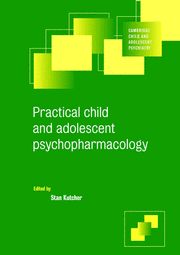Book contents
- Frontmatter
- Contents
- List of contributors
- Preface and acknowledgements
- 1 Child and adolescent psychopharmacology at the turn of the millennium
- 2 Developmental psychopharmacology
- 3 Clinical aspects of child and adolescent psychopharmacology
- 4 Depression
- 5 Bipolar mood disorders: diagnosis, etiology, and treatment
- 6 Schizophrenia and related psychoses
- 7 Obsessive–compulsive disorder
- 8 Anxiety disorders
- 9 Attention-deficit/hyperactivity disorder
- 10 Pervasive development disorder
- 11 Aggressive behavior
- 12 Adolescent substance use disorder
- 13 Tic disorders and Tourette's syndrome
- 14 Eating disorders and related disturbances
- 15 Medical psychiatric conditions
- Index
3 - Clinical aspects of child and adolescent psychopharmacology
Published online by Cambridge University Press: 31 August 2009
- Frontmatter
- Contents
- List of contributors
- Preface and acknowledgements
- 1 Child and adolescent psychopharmacology at the turn of the millennium
- 2 Developmental psychopharmacology
- 3 Clinical aspects of child and adolescent psychopharmacology
- 4 Depression
- 5 Bipolar mood disorders: diagnosis, etiology, and treatment
- 6 Schizophrenia and related psychoses
- 7 Obsessive–compulsive disorder
- 8 Anxiety disorders
- 9 Attention-deficit/hyperactivity disorder
- 10 Pervasive development disorder
- 11 Aggressive behavior
- 12 Adolescent substance use disorder
- 13 Tic disorders and Tourette's syndrome
- 14 Eating disorders and related disturbances
- 15 Medical psychiatric conditions
- Index
Summary
Introduction
When his car stopped running, a man had his car towed to the mechanic. The mechanic opened the hood, contemplated the interior for a minute or two, took out his wrench, and tightened a bolt. When he turned on the ignition, the car miraculously started. The bill was for $95.98. The man asked how the bill was figured, given how little effort was involved. The mechanic said it cost 98 cents to turn the bolt and $95 to know which bolt to turn. Similarly, psychopharmacologic treatment is not simply writing prescriptions; it is knowing how and when to do so.
Knowing “when to do so” is at the core of a psychiatric assessment. Making the correct diagnosis is akin to solving a murder-mystery. Just as one needs to have a considerable amount of information about the murder and its victim in order to discover who did it, there needs to be considerable understanding of the problem in order to give it a diagnosis. In both situations, it is necessary to be active in obtaining information. The more complicated the case, the more information sources must be contacted. One must sort through a considerable body of evidence, not all of which carries equal weight. There may be several suspects or other diagnoses that must be eliminated.
Keywords
- Type
- Chapter
- Information
- Practical Child and Adolescent Psychopharmacology , pp. 70 - 90Publisher: Cambridge University PressPrint publication year: 2002
- 4
- Cited by

